Deus Ex: Mankind Divided Review
Ventilation shafts are the heart and soul of the Deus Ex franchise. Since the original released in 2000, nothing else is as reliable when completing objectives. Sure, those iconic Augmentations that turn you invisible or reduce damage are useful, but eventually you will run out of energy. Traditional weapons, like the combat rifle or stun gun, have a purpose, but at some point ammo reserves will expire. And what about talking your way out of a situation? That works too, but eventually patience wears thin. Vents are different. They are always there to guide, hide and protect. These glorious elongated metallic tunnels will take you on shortcuts, long-cuts and back to the same room in one of those embarrassing navigational blunders. A Deus Ex sequel without vents is not a Deus Ex game at all. And just so you know, Deus Ex: Mankind Divided has a lot of vents.
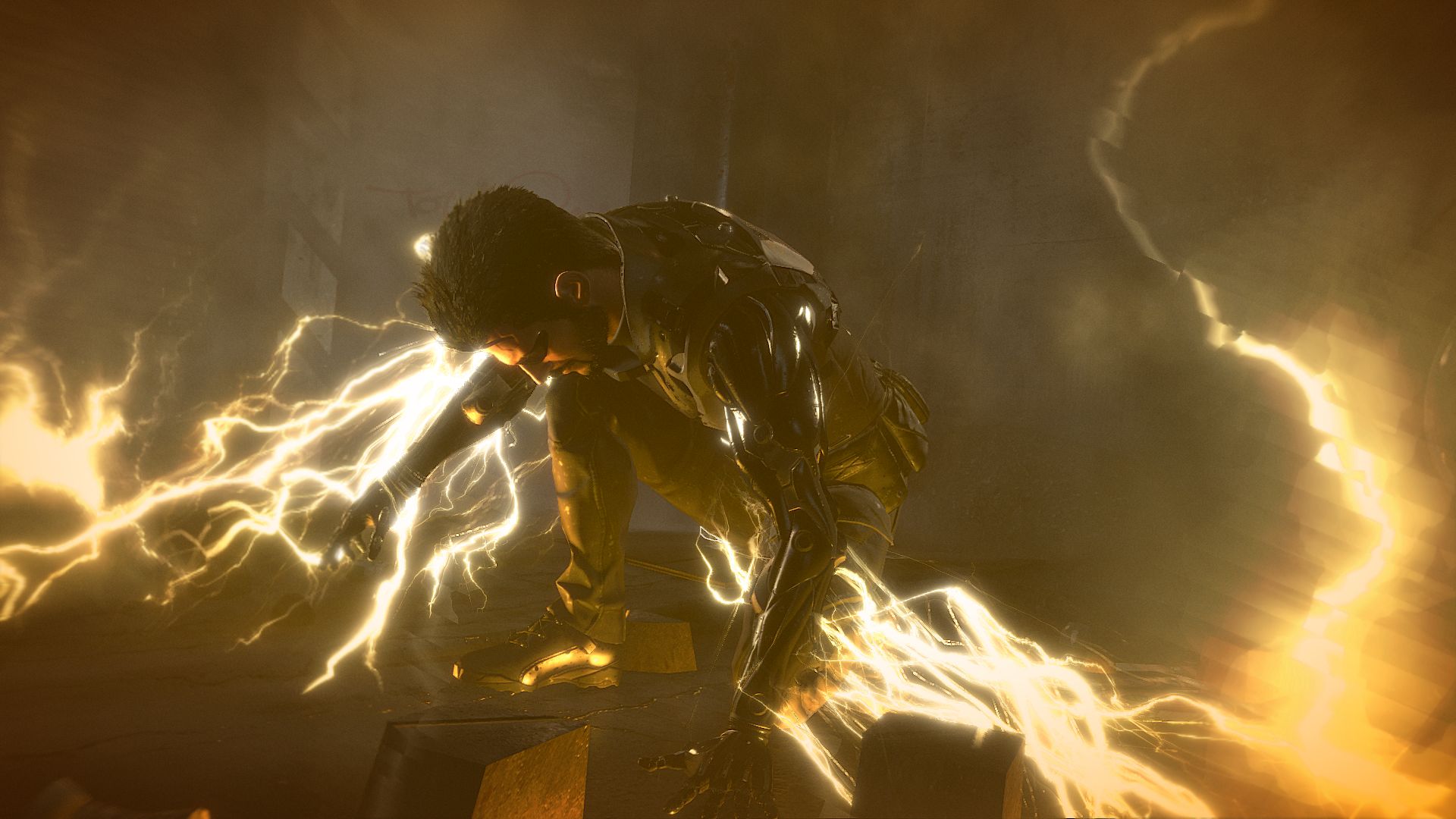
Adam Jensen drops by for another cyberpunk adventure
Before Adam Jensen can explore all the vents in Mankind Divided, we must reflect on the final events in Human Revolution. The cyberpunk prequel ended with millions of Augmented people going crazy, murdering others against their will. After the chaos abated, the Naturals (unaugmented) feared the remaining enhanced. This created segregation across the world and now the Augmented, like Jensen himself, are treated like scum. This dichotomy is adequately represented in the main location of Prague, as the Augmented are forced to take special trains and live in a downtrodden corner of the city. Set in 2029, two years after the previous game, Jensen will be embroiled in the havoc that surrounds this divide.
Adam Jensen is now working for Interpol, more specifically a covert task force (TF29) with headquarters located in Prague. Before players can explore the city, they must complete an opening mission in Dubai. This starter level is a fantastic tutorial because it gives players nearly all augmentations, allowing them to see which suit their play style best. Like its predecessors, Mankind Divided emphasizes choice through conversation, stealth, action, alternate routes, or information collection and this first area provides many options. On returning to Prague, a dramatic event disables Jensen’s augmentations and he must start from scratch—one of several clever devices that mesh the basic RPG mechanics with story.
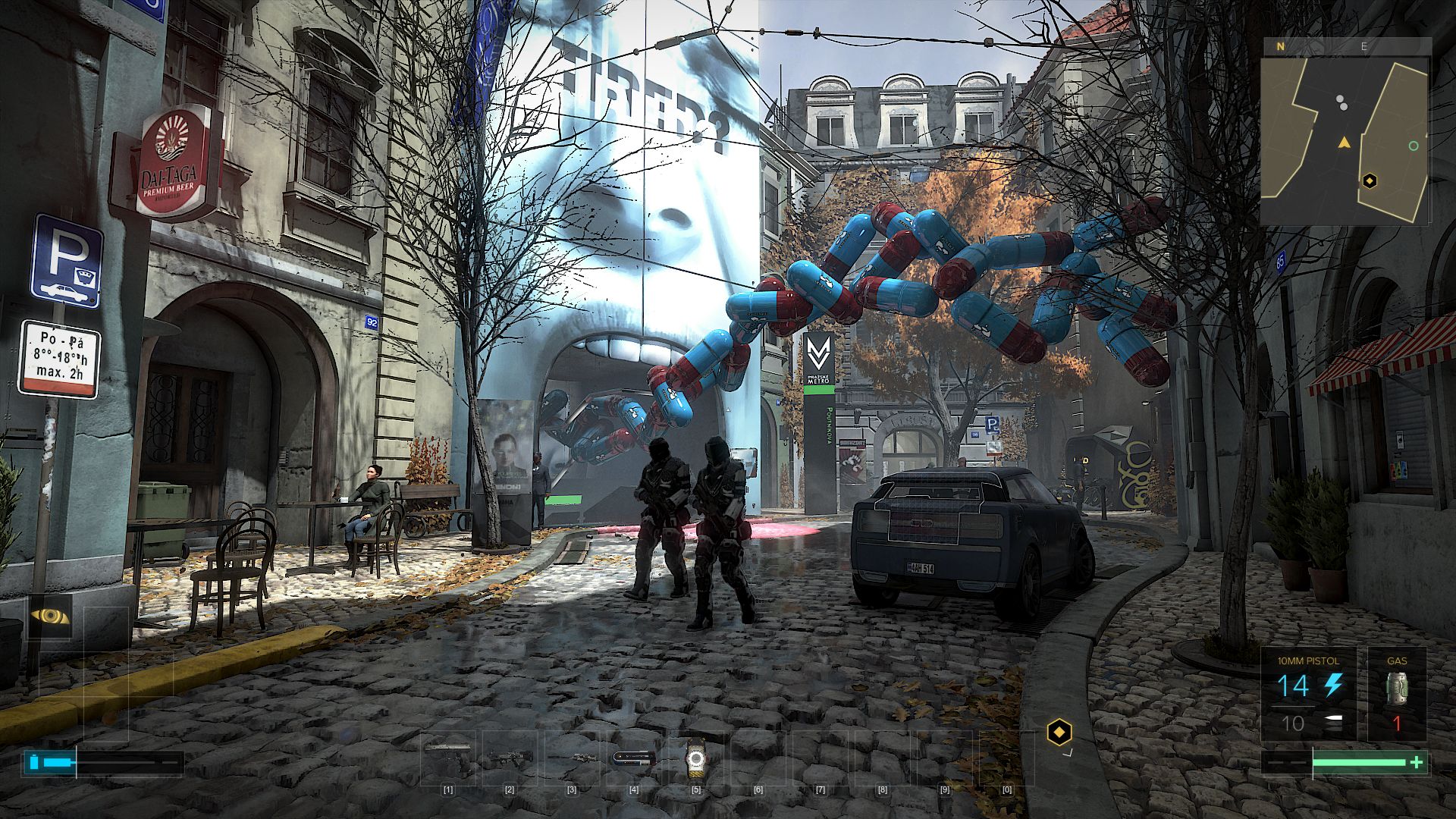
Prague is a great hub with many places to explore
Prague is a beautiful city and a great open world hub. It is a clear improvement over Detroit and Hengsha from the previous game. Shops are unique, streets become familiar, and the open layout is pleasing to navigate. Across the city there are many artistic designs that draw the eye, from holographic displays to advertising sculptures. There are rooftops to explore, alleys with storage garages to unlock, apartments to raid, and sewers in which to get lost. The city is split into two sections with Jensen’s apartment situated in the smaller part. Travelling between the two hubs is common—and a test of patience thanks to modest load times. Prague changes throughout the game, as Jensen later returns at night when stores close and the red-light district comes alive.
Missions make excellent use of each corner in Prague. One optional side mission takes Jensen to a Bank that safeguards information, and he must navigate its multi-tiered granite floors to find proof that will deflect prying eyes. Another has Jensen investigating a murderer with a penchant for harvesting augmentations. These side missions allow Jensen to dictate outcomes either by choosing his words or deciding on specific actions. Away from the city, several missions will take Jensen to bigger game spaces that have a more traditional structure.
Throughout the city, and across other locations, there are many characters that become part of the intriguing story. Naturally this means a lot of conversations but, fortunately, the subject matter is engrossing. There are text-based interactions too although not nearly enough given the setting. The conspiracy element is rife and the story ties elegantly into the original. For stalwarts of the series, returning themes relating to the Illuminati and AI constructs will feel comfortably familiar. Determining character allegiances is ever a concern and this culminates into tough decisions regarding the disclosure of information.
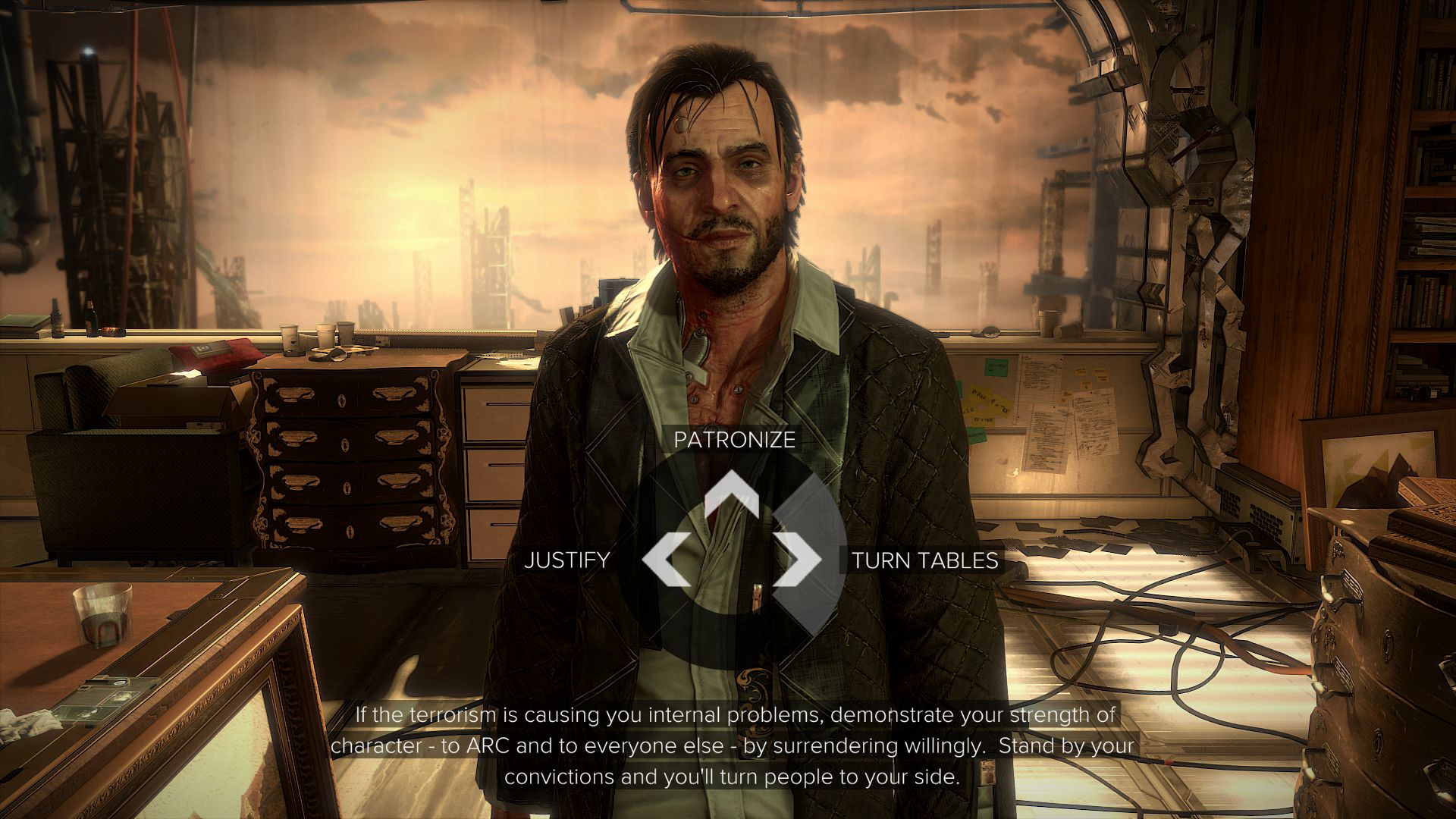
Pivotal conversations can have different outcomes
Helping to drive the story is succinct and intelligent dialogue, with careful drops of sarcasm. Many conversations offer avenues to gather information or skip to a resolution. Players can return to the TF29 base and talk to key personnel, although this doesn’t quite reach its potential. Choose your words smartly and you can avoid conflict or find more information that helps later in the game.
When it comes to action, this is a game all about options. Hostile zones are clearly marked, and being spotted means trouble. Should you not wish to stand toe-to-toe with armor plated foes, then there are usually several navigation paths to the objective. For example, use a jump augmentation to climb on walkways. Or clamber through vents and use your hacking skills to open doors. Of course, you could go the direct path and use glass armor and ample sticky-cover to avoid detection. Finding the ideal route is nearly as fun as executing the actual incursion.
Mankind Divided encourages stealth and non-lethal play heavily. Enemies on patrol—such as the state police or augmented groups—rarely justify deadly force. The game throws too much doubt towards factions that could have been massaged into the traditional bad guy role. When less favourable types arrive, whipping out your shotgun may compromise innocents or hypothetically cause more problems. Besides, taking on a local crime gang within earshot of the police just seems like bad idea.
So sneaking is a major focus, and it works alright despite limitations. There are more options for non-lethal outcomes than in Human Revolution, including a Typhoon gas attack and a Tesla arc device, but these couldn’t replace the traditional upgrades involved with hacking, invisibility, strength, inventory size, and energy management. So you may be left with reliable stealth methods—melee takedown, tranquilizer rifle, stun gun, X-ray vision, and gas grenades. The snap range for cover is short, but this emphasizes crouch-sneaking and careful navigation. Shadows are irrelevant in stealth, as distances and line of sight are all that matters. Making loud noises is a concern, although throwing objects is an effective way to separate guards.
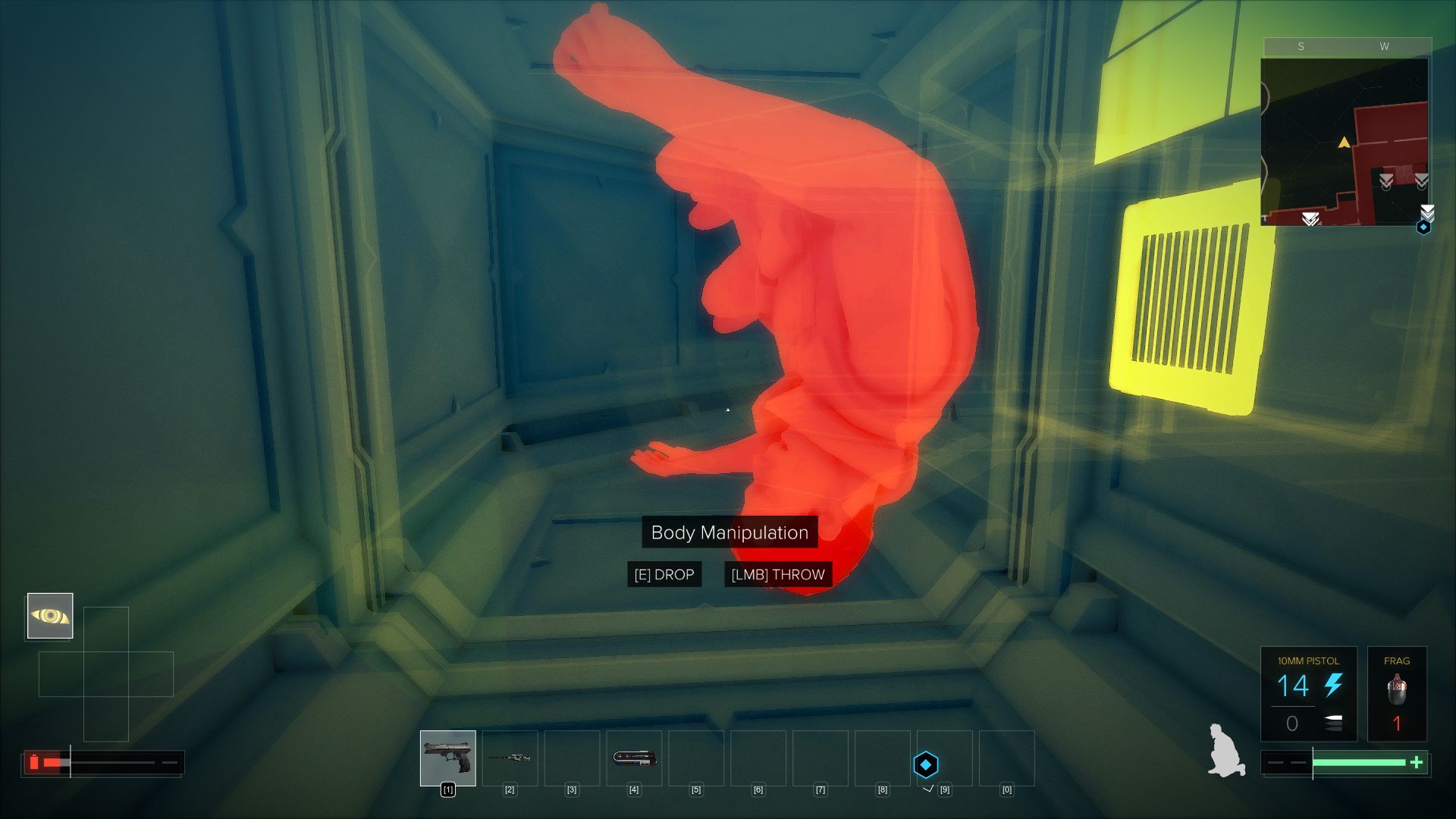
Vents are a great place to hide bodies
The hostile AI is capable, although without the interplay seen in other stealth games. They spot movement and search, but other guards don’t care if their friends fail to return. Dopey security personnel failed to notice me rapidly opening and closing a door until they were standing close enough to get their nose caught in it. They do spot incapacitated bodies, so hiding ragdolls is fairly important. Enemies are meant to wake sleeping guards, but some stared and contemplated life, presumably unable to find a path to the body. Stealth is decent, but the covert approach would have excelled with a bit more depth.
The hostile areas you infiltrate are straightforward and perhaps too predictable. There is a direct route containing the most foes and a few adjacent passageways. Patrols are rarely inhibitory because many guards are stationary or have basic paths. Our friend, the vent, returns in abundance and many situations can be avoided using its comforting interiors. As expected, some vent entrances are arbitrary; linking two rooms for no reason other than it was a good place for an alternative path. Their entry requirement is minimal—you may need the jump-boost augmentation to reach one, or a strength upgrade to move yet another photocopier out of the way. Only near the end do vents become more complex than a single passage. Nothing forces players to use vents, but given their reliability, protection, and possibility to discover a secret area, they remain ever tempting.
Despite the discouragement towards deadly force, there are some good options if you wish to shoot ‘em up. Weapon stats, like damage and reload speeds, can be upgraded using crafting resources; alternatively, they can be used to make energy sources or hacking devices among other things. There are some deadly Augmentations, such as the one that slows time allowing you to pop headshots like a super-augmented government agent from the future. The defensive upgrades are nearly a must given how little damage Jensen can absorb by default. Although there are some caveats, players with a violent streak will be appeased.
Whichever approach you choose, the campaign is a well-oiled machine. The story flows wonderfully around side missions with twists and subtle choices. Difficulty spikes are fair and justifiable followed by suitable periods of relief. While the story is interesting, it may come across like chapter one in an epic saga. This is due to it being a prequel that gives credence to the game that started it all.
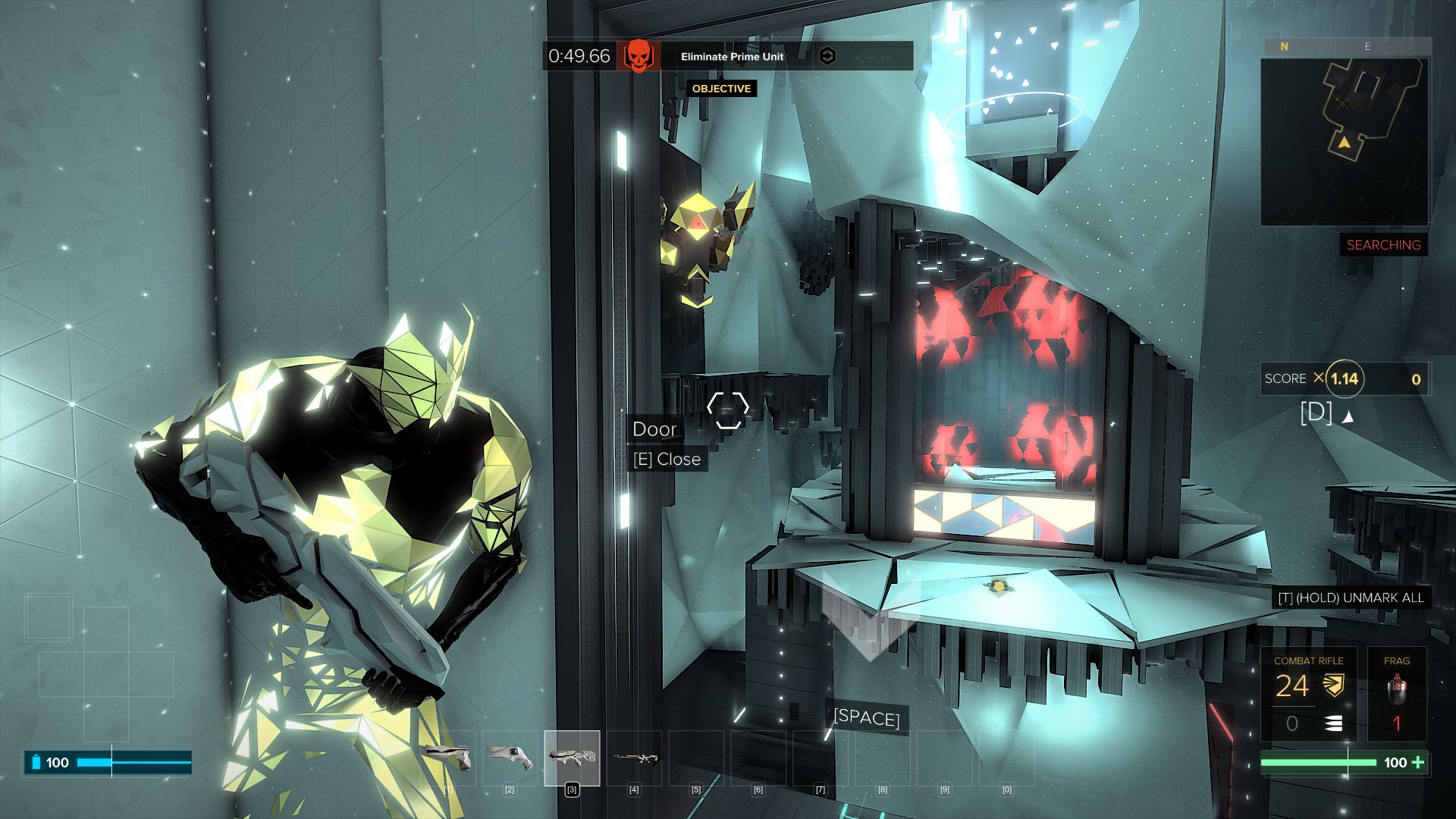
Breach is a puzzle version of the core mechanics
Even though the campaign provides good value, there is a separate mode called Breach that offers compressed action. Players take the role of a hacker and will use virtual reality to infiltrate and escape servers. This translates into a digitised version of the same mechanics from the campaign across puzzle levels that take a few minutes to complete. Like recent multiplayer games or freemium mobile games, booster packs and unique currency will provide weapons, upgrades, and level modifiers. You can also pay real money—the game annoyingly reminds you when you are fresh out of packs—although it takes hours before this comes into consideration. The best thing about Breach is decimating AI constructs because there is no moral hesitation.
Outside the individual Breach levels, there are several text-based interactions with fictional characters. These were sorely missed in the campaign and are paired with case files that culminate into news reports. Breach will provide a few hours of entertainment before the difficulty and time restraints start to smother progress as repeating levels becomes standard. A selection of the finest Breach levels should have been integrated into the campaign to offer players staggered and diverse challenges that would contrast with the rest of the action. Linking them to story events would have made the entire game better than the sum of its parts. Instead, Breach floats out there in cyberspace, waiting for a booster pack purchase.
Even without Breach mode, Mankind Divided is several games in one and prone to technical issues. The good news is that most problems are minor. Moving boxes is a regular task, but the act of climbing on physics objects is painful. Using a heavy soda machine to create a shortcut got quite disturbing when one began to “walk” towards me as though there was a ghost in the machine. Standing on boxes is common in Breach and it was awfully frustrating to see them ricochet away while the clock was ticking. Physics issues extend to ragdoll bodies, like when a guard squeezed through a solid handrail and alerted enemies below while Jensen punched the ground. As perfect as vents are, there were a few paranormal hotspots that made me visible to guards. And finally, Jensen had trouble ascending stairs. Running up them was slower than walking and some behaved as if they were covered in grease, causing Jensen to slide around the stairwell like a pinball.
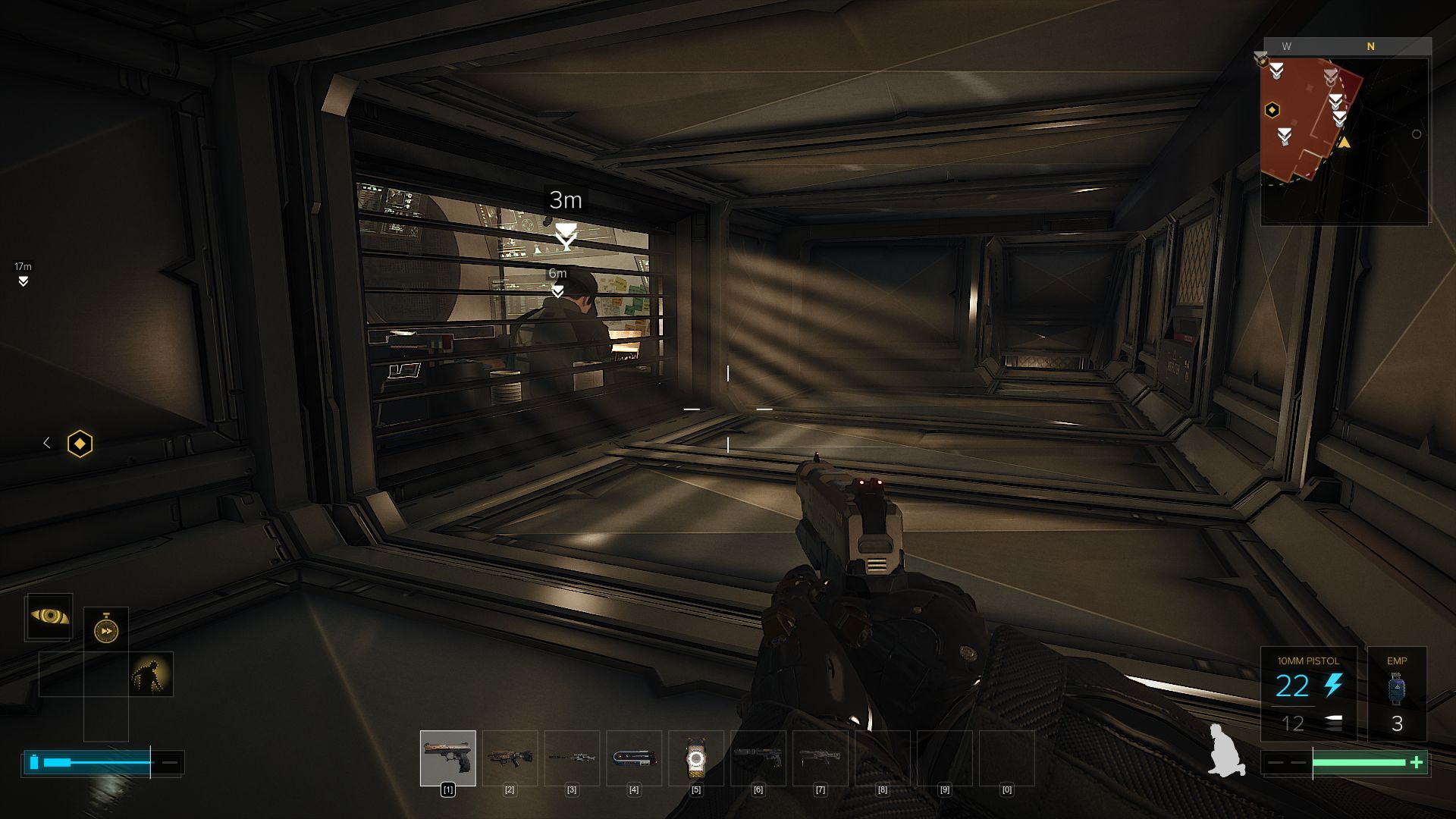
The decisions are augmented and the locations are well vented
After the 20-30 hour-long campaign, Deus Ex: Mankind Divided will come to a sudden yet agreeable conclusion. It still feels like a taster of something grander with many steps remaining in the journey. For now, players will be satisfied with a broad range of options, branching missions, captivating dialogue, shady characters and a decent amount of interaction. Infiltrations can be approached covertly or aggressively which provides good replay value. And although stealth is limited and deadly force is hard to justify, the freedom of engagements is delightful. All of this is supported by the city of Prague, a wonderful hub that is almost perfectly utilized, and a few other carefully-designed locations. This is a sequel that stands alongside Human Revolution and that makes it essential for series fans itching to get back into those nurturing vents—whichever direction they may lead.
